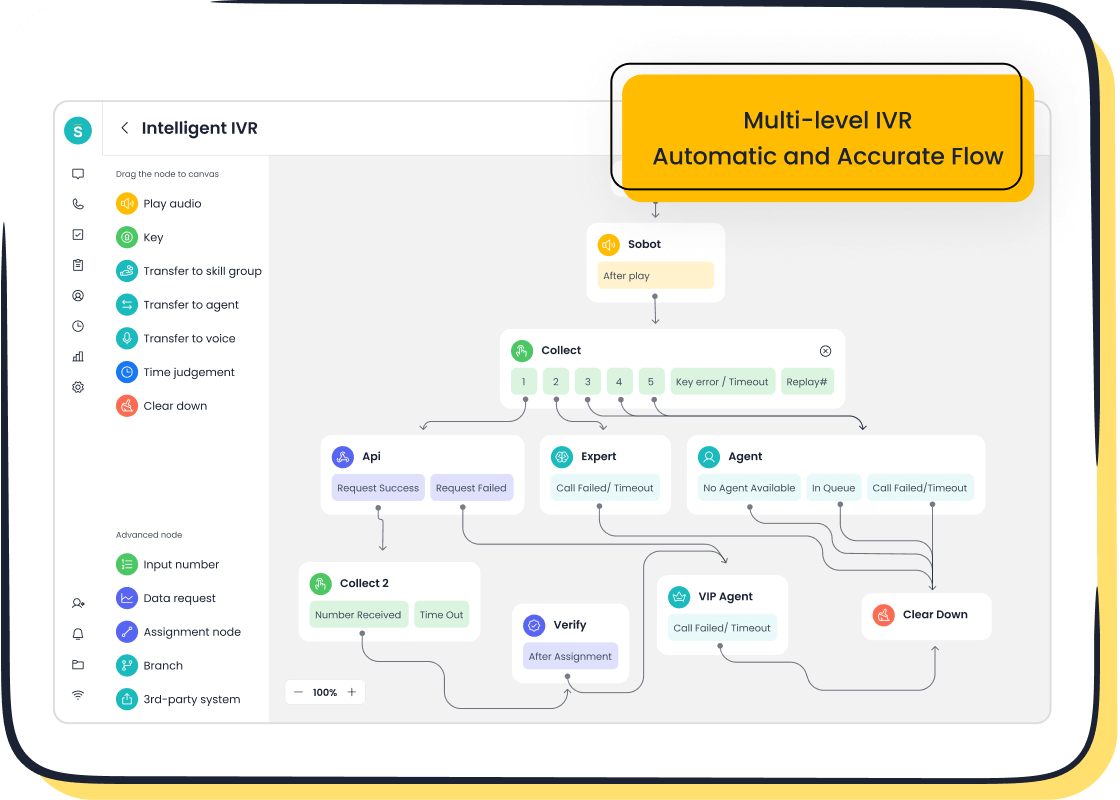The Role of Client Service Skills in Different Industries

Client service management skills pave the way for lasting professional success. These abilities influence how you interact with customers and shape their perception of your business. Statistics reveal that 85% of customers prefer companies offering excellent service, and 93% are more likely to return after a positive experience. Businesses that prioritize customer service management often see revenue growth of up to 8% above market averages. Tools like Sobot simplify the customer journey with their customer service strategy solutions, ensuring satisfaction and loyalty. Your ability to manage client interactions effectively can transform one-time buyers into lifelong customers.
Understanding Client Service Skills
What are client service management skills?
Client service management skills are the abilities you use to ensure customers have a positive experience when interacting with your business. These skills include understanding customer needs, effective communication, and problem-solving. They help you build trust and maintain strong relationships with clients. For example, when a customer contacts you with an issue, your ability to listen attentively and provide a solution reflects these skills.

Customer service is not just about solving problems; it’s about creating value. It involves supporting customers before, during, and after a sale. This ensures they feel confident and valued throughout their journey. Tools like Sobot’s Voice/Call Center can enhance your ability to manage client interactions by providing features like intelligent call routing and real-time monitoring. These tools make it easier to meet customer needs efficiently.
Key components of good customer service
Good customer service relies on several key components that ensure customer satisfaction. These include attentiveness, clear communication, and emotional intelligence. Attentiveness means actively listening to what customers say and understanding their concerns. Clear communication helps you explain solutions in a way that customers can easily understand. Emotional intelligence allows you to connect with customers on a personal level, making them feel valued.
| Component | Description |
|---|---|
| Best available evidence | Integration of the most reliable and relevant research findings into practice. |
| Clinical expertise | The practitioner's own experience and skills in providing care. |
| Patient values and circumstances | Consideration of the individual needs and preferences of the patient in decision-making. |
Studies show that customer satisfaction directly impacts profitability. For instance, Anderson and Sullivan (1993) found that satisfying current customers increases future profitability. Similarly, Reichheld and Sasser (1990) highlighted how high-quality service boosts loyalty and positive word-of-mouth.
Why empathy and problem-solving are essential in client service
Empathy and problem-solving are at the heart of strong customer service. Empathy helps you understand and share the feelings of your customers. This connection builds trust and makes customers feel heard. For example, Zappos once sent flowers and a sympathy card to a customer who lost her mother, showcasing genuine care.
Problem-solving ensures you can address customer issues effectively. It involves analyzing the situation, identifying the root cause, and providing a solution. Apple Support trains its agents to use empathy and problem-solving together, creating a seamless experience for customers. Sobot’s AI-powered Voicebot can assist in this process by recognizing customer intent and offering intelligent solutions, saving time and improving customer focus.
Variations of Client Service Skills Across Industries

Retail and e-commerce: Meeting diverse customer expectations
In retail and e-commerce, your ability to meet diverse customer expectations defines success. Customers today demand more than just products; they expect seamless experiences and personalized interactions. Studies show that 63% of consumers believe the best brands exceed expectations throughout the customer journey. Additionally, 67% of customers report that their standards for good customer experience are higher than ever. This means you must adapt your customer service skills to cater to these rising expectations.
Personalization plays a critical role in building strong customer relationships. For instance, 52% of customers are likely to switch brands if communication isn’t personalized. By understanding customer preferences and tailoring your approach, you can foster loyalty and satisfaction. Tools like Sobot’s Omnichannel Solution help you unify communication channels, ensuring consistent and personalized interactions. This platform allows you to manage inquiries from social media, email, and live chat in one place, making it easier to exceed customer expectations.
Moreover, speed is essential in retail. About 90% of customers find it important to receive immediate responses to support questions. A well-trained customer service team equipped with tools like Sobot’s AI-powered Voicebot can handle repetitive queries efficiently, allowing you to focus on more complex issues. This not only improves response times but also enhances the overall customer experience.
Technology and SaaS: The role of customer service skills in innovation
In the technology and SaaS industry, customer service skills drive innovation. Your ability to empathize with users, solve problems, and think creatively can lead to groundbreaking solutions. For example, empathy helps you understand customer pain points, which can inspire new features or services. Problem-solving ensures you address challenges effectively, fostering a culture of continuous improvement.
| Skill | Contribution to Innovation |
|---|---|
| Empathy | Builds emotional connections, leading to better feedback and innovative ideas. |
| Problem-solving | Resolves challenges quickly, encouraging effective and innovative solutions. |
| Creativity | Promotes out-of-the-box thinking for unique customer solutions. |
| Technical proficiency | Helps guide customers effectively, enabling innovative uses of technology. |
| Relationship building | Cultivates trust, encouraging customers to share insights that drive innovation. |
| Data-driven decision making | Analyzes customer behavior to inform strategic planning and innovation. |

Leveraging AI and machine learning further enhances your ability to innovate. These technologies personalize customer experiences and improve operational efficiency. For example, Sobot’s Voice/Call Center uses AI-powered Voicebots to recognize customer intent and provide intelligent solutions. This not only saves time but also allows your customer service team to focus on strategic tasks. Regularly monitoring KPIs and customer feedback can also help you identify trends and areas for improvement, ensuring your services remain cutting-edge.
Hospitality and tourism: Delivering personalized experiences
In hospitality and tourism, delivering personalized experiences is key to building lasting customer relationships. Guests expect tailored services that make them feel valued. Understanding their preferences allows you to create memorable experiences. For example, hotels that use technology to personalize the guest journey often see higher satisfaction rates. Metrics like Net Promoter Score (NPS) help measure service quality, categorizing guests into promoters, passives, and detractors.
| Evidence | Description |
|---|---|
| Guest Preferences | Understanding guest preferences is crucial for providing tailored experiences. |
| Technology Utilization | Hoteliers are increasingly using technology to personalize the guest journey. |
| Positive Impact | Tailored services lead to improved guest loyalty and satisfaction. |
Satisfied guests are more likely to spend on additional services, increasing revenue. Real-time feedback systems can improve satisfaction scores by 18%-24%. For instance, Sobot’s Omnichannel Solution enables you to gather and analyze guest feedback across multiple channels. This helps you identify areas for improvement and deliver exceptional service. Tailored services also lead to a 23% higher Average Daily Rate (ADR) and a 34% increase in ancillary spending per guest, proving the value of personalization in this industry.
Financial services: Building trust through effective communication.
In financial services, trust is the foundation of every client relationship. Your ability to communicate effectively can make or break that trust. Clients rely on you to handle their sensitive financial information, provide sound advice, and address their concerns promptly. Clear, transparent communication reassures clients that their interests are your top priority.
Why Communication Matters in Financial Services
Effective communication fosters loyalty and encourages long-term relationships. When clients feel heard and understood, they are more likely to stay with your firm and recommend your services to others. Metrics like client retention rate and Net Promoter Score (NPS) highlight the impact of communication on trust and satisfaction:
| Metric | Description |
|---|---|
| Client Retention Rate | Measures the percentage of clients retained over a period. |
| Client Referral Rate | Indicates the rate at which clients refer new clients. |
| Net Promoter Score (NPS) | Assesses client satisfaction and loyalty through surveys. |
| New Client Growth % | Evaluates the percentage increase in new clients acquired. |
| New Asset Growth % | Measures the growth in assets under management from new clients. |
For example, a high client retention rate signals that your communication strategies are effective. Similarly, a strong NPS reflects satisfied clients who trust your services enough to recommend them.
Real-World Examples of Communication Excellence
Several financial institutions have demonstrated the power of excellent communication. Citibank uses customer journey mapping to understand the end-to-end client experience. This approach led to a 25% increase in customer satisfaction and a 15% reduction in service complaints. HSBC implemented real-time feedback tools in its mobile app, resulting in a 20% boost in satisfaction scores. American Express took it a step further by using emotional AI to tailor interactions based on client emotions, achieving a 25% improvement in satisfaction scores.
| Case Study | Strategy Description | Impact |
|---|---|---|
| Citibank | Uses customer journey mapping to analyze the end-to-end experience of clients. | 25% increase in customer satisfaction, 15% reduction in service complaints. |
| HSBC | Implements real-time feedback tools in its mobile app for immediate customer input. | 15% decrease in service complaints, 20% increase in customer satisfaction. |
| American Express | Utilizes emotional AI to tailor interactions based on customer emotions. | 25% improvement in customer satisfaction scores, 15% reduction in service escalations. |
These examples show how innovative communication strategies can transform client relationships and drive measurable results.
How Sobot Enhances Communication in Financial Services

Sobot’s solutions can help you build trust through seamless and effective communication. The Voice/Call Center offers features like intelligent call routing and real-time monitoring, ensuring that clients connect with the right agent quickly. Its AI-powered Voicebot recognizes client intent, providing instant solutions to common queries. These tools reduce wait times and improve the overall client experience.
Additionally, Sobot’s Omnichannel Solution unifies communication across platforms like email, phone, and chat. This ensures that your clients receive consistent and personalized service, no matter how they choose to reach out. By integrating these tools into your operations, you can enhance transparency, address concerns efficiently, and strengthen client trust.
Tip: Regularly monitor client feedback and adjust your communication strategies to meet their evolving needs. Tools like Sobot’s analytics can provide valuable insights to help you stay ahead.
In financial services, trust is not just earned—it is maintained through every interaction. By prioritizing clear and empathetic communication, you can build lasting relationships that drive growth and loyalty.
Benefits and Challenges of Applying Client Service Skills
Advantages of transferable client service management skills
Client service skills are highly transferable, making them valuable across industries. These skills allow you to adapt to different roles and environments, enhancing your career flexibility. For example, problem-solving and clear communication are essential whether you work in retail, technology, or financial services. They help you address customer concerns effectively and build trust.
Transferable skills also improve collaboration within teams. When you communicate clearly and empathize with others, you foster a positive work environment. This collaboration leads to better customer service interactions and stronger customer loyalty. For instance, a retail team that works together seamlessly can provide faster and more personalized service, increasing customer satisfaction.

Customer service training further enhances these skills, ensuring you stay proactive in meeting customer needs. Tools like Sobot’s Voice/Call Center support this by offering features such as intelligent call routing and real-time monitoring. These tools streamline processes, allowing you to focus on delivering exceptional service.
Common challenges in adapting to industry-specific demands
Adapting client service skills to specific industries can be challenging. Each sector has unique customer expectations and operational requirements. For instance, in financial services, clients expect clear communication and confidentiality. In contrast, the hospitality industry prioritizes personalization and proactive service.
Industry analyses and feedback surveys highlight common challenges when adapting skills:
- Encouraging participation in feedback processes without overwhelming customers.
- Ensuring feedback represents the entire customer base, including diverse demographics.
- Extracting actionable insights from vague or generic feedback.
- Avoiding feedback fatigue by balancing the frequency of surveys.
- Correctly interpreting feedback to address the root problem.
- Integrating feedback into business processes to drive meaningful change.
These challenges require a strategic approach. For example, using Sobot’s Omnichannel Solution can help you gather and analyze feedback across multiple channels. This ensures you understand customer needs and adapt your strategy effectively.
Overcoming obstacles with tools like Sobot's Voice/Call Center
Technology plays a vital role in overcoming client service challenges. Sobot’s Voice/Call Center offers solutions that simplify complex processes. Its intelligent call routing ensures customers connect with the right agent quickly, reducing frustration. The AI-powered Voicebot recognizes customer intent, providing instant solutions to common problems.
Real-time monitoring and analytics help you identify trends and improve service quality. For example, if data shows frequent complaints about response times, you can adjust your strategy to address this issue. The platform also supports collaboration by unifying customer data in one workspace. This allows your team to work together more efficiently, enhancing customer service interactions.
By leveraging tools like Sobot’s Voice/Call Center, you can overcome industry-specific challenges and deliver exceptional service. These tools not only improve operational efficiency but also strengthen customer loyalty, ensuring long-term success.
Industry-Specific Demand and Career Outlook

High-demand industries for client service professionals
Client service professionals are in high demand across industries that prioritize customer satisfaction and operational efficiency. In North America, the customer service sector holds a 35.4% market share, reflecting its significant contribution to business growth. In the UK, professional services contribute £243.7 billion to the Gross Value Added (GVA), showcasing the economic importance of client service roles. Globally, the market for customer service solutions is projected to reach $72.61 billion by 2024, with a compound annual growth rate (CAGR) of 5.62% from 2024 to 2029.
Industries such as retail, financial services, and technology are leading this demand. Professional services alone are expected to grow to $95.44 billion by 2029. This growth is fueled by accelerated digital transformation, with 88% of business development professionals reporting increased adoption of digital tools since 2019. Additionally, 84% of leaders in professional services feel pressure to integrate AI into their operations, creating opportunities for tech-savvy client service professionals.
Sobot’s solutions, such as the Voice/Call Center and Omnichannel Solution, align perfectly with these industry needs. These tools empower businesses to streamline customer support processes, improve communication, and enhance customer satisfaction. By leveraging Sobot’s advanced technologies, you can position yourself as a valuable asset in high-demand industries.
Emerging trends in customer service skills and technology
Customer service is evolving rapidly, driven by technological advancements and changing consumer expectations. Automation and AI are transforming customer support from reactive to proactive, enabling businesses to anticipate customer needs and deliver personalized experiences. Scalable AI tools, like Sobot’s AI-powered Voicebot, streamline repetitive tasks, allowing human agents to focus on high-value interactions.
Continuous training is another emerging trend. Companies are investing in upskilling employees to ensure they can leverage new tools effectively. Training programs that combine technology with empathy, problem-solving, and communication skills create well-rounded customer support agents. For example, Sobot’s unified workspace integrates customer data across channels, helping agents provide empathetic and efficient support.
The impact of these trends is significant. By 2027, 23% of current jobs will change, with 69 million new roles created and 83 million eliminated. Organizations are responding by prioritizing employee development, with 82% planning to invest in training programs to adapt to technological changes. Sobot’s solutions support this shift by offering tools that enhance both technical proficiency and interpersonal skills, ensuring you stay ahead in the evolving customer service landscape.
How Sobot supports career growth in client service roles

Sobot provides a robust platform for professionals looking to advance their careers in customer support. Its Voice/Call Center offers features like intelligent call routing, real-time monitoring, and AI-powered Voicebots, enabling you to deliver exceptional service while improving operational efficiency. These tools help you develop critical skills, such as problem-solving and data-driven decision-making, which are essential for career growth.
The Omnichannel Solution further enhances your capabilities by unifying communication channels like email, chat, and social media. This ensures consistent and personalized customer interactions, allowing you to build stronger relationships and improve customer satisfaction. By mastering these tools, you can position yourself as a leader in client service roles across industries.
Sobot also supports continuous learning through analytics and performance insights. These features help you identify areas for improvement and refine your strategies. For example, real-time feedback systems provide actionable data, enabling you to adapt quickly to changing customer needs. With Sobot’s solutions, you can stay ahead of industry trends and achieve long-term career success in customer support.
Tip: Explore Sobot’s training resources and tools to enhance your skills and stay competitive in the evolving customer service industry.
Finding the Best Industry Fit for Your Client Service Skills
Assessing your strengths and preferences for good customer service
Understanding your strengths and preferences is the first step in finding the right industry for your client service skills. Start by identifying the tasks you enjoy most. Do you excel at solving problems, or do you prefer building long-term relationships with customers? Reflect on your past experiences to uncover patterns. For example, if you’ve thrived in fast-paced environments, retail or e-commerce might suit you. If you value precision and trust, financial services could be a better fit.
Consider your communication style as well. Some industries, like hospitality, require a warm and empathetic approach. Others, such as technology, demand technical proficiency and clear explanations. Tools like Sobot’s Voice/Call Center can help you refine these skills by offering real-time monitoring and intelligent call routing. These features allow you to focus on what you do best while improving your overall efficiency.
Matching your skills to industry-specific needs
Matching your skills to industry demands requires a clear understanding of what each sector values. Research shows that skills-based organizations focus on aligning individual abilities with specific roles. This approach ensures a better fit between your strengths and the job requirements. For example:
- Retail emphasizes adaptability and quick problem-solving.
- Financial services prioritize trust-building and confidentiality.
- Technology values creativity and data-driven decision-making.
By defining your skills, interests, and motivations, you can identify industries where you’ll thrive. For instance, if you’re skilled at managing multiple communication channels, Sobot’s Omnichannel Solution can enhance your ability to deliver seamless customer service. This tool integrates platforms like email, chat, and social media, making it easier to meet industry-specific expectations.
Leveraging Sobot's solutions to transition into new industries
Transitioning into a new industry can feel challenging, but the right tools make it easier. Sobot’s solutions provide a strong foundation for adapting your client service skills. The Voice/Call Center, for example, simplifies communication with features like AI-powered Voicebots and global number availability. These tools help you manage customer interactions efficiently, regardless of the industry.
If you’re entering a field like hospitality, Sobot’s Omnichannel Solution ensures you can deliver personalized experiences across multiple platforms. For technology or SaaS roles, the platform’s data analytics capabilities allow you to track performance and refine your strategies. These features not only improve customer satisfaction but also help you build confidence in your new role.
Tip: Use Sobot’s analytics to identify areas for improvement and tailor your approach to meet industry demands. This proactive strategy will set you apart as a client service professional.
By assessing your strengths, aligning them with industry needs, and leveraging tools like Sobot, you can find the perfect fit for your client service skills and achieve long-term success.
Client service skills are essential for building trust, resolving issues, and driving customer satisfaction across industries. Whether in retail, technology, or financial services, these skills adapt to meet unique demands, shaping your career growth. For example, 94% of American customers recommend companies with excellent service, and 83% feel loyal to brands that resolve complaints effectively.
| Statistic | Source |
|---|---|
| 90% of customers say issue resolution is their top concern. | KPMG |
| 90% of customers value an immediate response to their questions. | HubSpot |
| A third of customers prioritize solving their problem in one interaction. | Statista |
| 83% of customers feel more loyal to brands that resolve complaints. | Forrester |
| 94% of American customers recommend a company with very good service. | Qualtrics XM Institute |
By leveraging tools like Sobot’s Voice/Call Center, you can streamline communication, resolve issues faster, and deliver personalized experiences. These solutions not only enhance customer satisfaction but also position you for long-term success in client service roles.
Tip: Invest in training and tools to refine your client service skills. Sobot’s solutions can help you stay ahead in this evolving field.
FAQ
What are the most important client service skills to develop?
The most important skills include empathy, problem-solving, and clear communication. These abilities help you understand customer needs, resolve issues effectively, and build trust. For example, using tools like Sobot’s Voice/Call Center can enhance your communication by routing calls intelligently and providing real-time monitoring.
How can technology improve customer service?
Technology streamlines processes and enhances efficiency. AI-powered tools like Sobot’s Voicebot handle repetitive queries, allowing you to focus on complex issues. Omnichannel solutions unify communication channels, ensuring consistent customer experiences. These innovations reduce response times and improve satisfaction rates.
Why is customer feedback essential in client service?
Customer feedback helps you identify areas for improvement and adapt your strategies. For instance, real-time feedback tools, like those in Sobot’s Omnichannel Solution, provide actionable insights. This ensures you meet evolving customer expectations and maintain high satisfaction levels.
How do client service skills vary across industries?
Different industries prioritize unique aspects of client service. Retail focuses on speed and personalization, while financial services emphasize trust and confidentiality. Tools like Sobot’s solutions adapt to these needs, helping you deliver tailored customer experiences regardless of the sector.
What role does training play in improving customer service?
Training enhances your ability to handle customer interactions effectively. Continuous learning ensures you stay updated on industry trends and tools. For example, Sobot’s analytics features help you refine your strategies, improving both your technical and interpersonal skills.
See Also
Exploring The Role Of IT Call Center Agents
Excelling In Live Chat For Retail Businesses
Top Strategies For Quality Management In Call Centers
